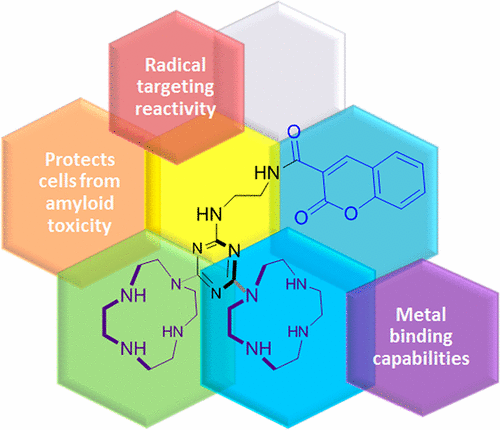当前位置:
X-MOL 学术
›
ACS Chem. Neurosci.
›
论文详情
Our official English website, www.x-mol.net, welcomes your
feedback! (Note: you will need to create a separate account there.)
Synthesis, Characterization, and Activity of a Triazine Bridged Antioxidant Small Molecule
ACS Chemical Neuroscience ( IF 4.1 ) Pub Date : 2017-08-22 00:00:00 , DOI: 10.1021/acschemneuro.7b00184 Paulina Gonzalez 1 , Kristof Pota 1 , Lara Su Turan 1 , Viviana C. P. da Costa 1 , Giridhar Akkaraju 2 , Kayla N. Green 1
ACS Chemical Neuroscience ( IF 4.1 ) Pub Date : 2017-08-22 00:00:00 , DOI: 10.1021/acschemneuro.7b00184 Paulina Gonzalez 1 , Kristof Pota 1 , Lara Su Turan 1 , Viviana C. P. da Costa 1 , Giridhar Akkaraju 2 , Kayla N. Green 1
Affiliation

|
Metal-ion misregulation and oxidative stress continue to be components of the continually evolving hypothesis describing the molecular origins of Alzheimer’s disease. Therefore, these features are viable targets for synthetic chemists to explore through hybridizations of metal-binding ligands and antioxidant units. To date, the metal-binding unit in potential therapeutic small molecules has largely been inspired by clioquinol with the exception of a handful of heterocyclic small molecules and open-chain systems. Heterocyclic small molecules such as cyclen (1,4,7,10-tetraazacyclododecane) have the advantage of straightforward N-based modifications, allowing the addition of functional groups. In this work, we report the synthesis of a triazine bridged system containing two cyclen metal-binding units and an antioxidant coumarin appendage inspired by nature. This new potential therapeutic molecule shows the ability to bind copper in a unique manner compared to other chelates proposed to treat Alzheimer’s disease. DPPH and TEAC assays exploring the activity of N-(2-((4,6-di(1,4,7,10-tetraazacyclododecan-1-yl)-1,3,5-triazin-2-yl)amino)ethyl)-2-oxo-2H-chromene-3-carboxamide (molecule 1) show that the molecule is antioxidant. Cellular studies of molecule 1 indicate a low toxicity (EC50 = 80 μM) and the ability to protect HT-22 neuronal cells from cell death induced by Aβ + copper(II), thus demonstrating the potential for molecule 1 to serve as a multimodal therapeutic for Alzheimer’s disease.
中文翻译:

三嗪桥联抗氧化剂小分子的合成,表征和活性
金属离子的失调和氧化应激继续是描述阿尔茨海默氏病分子起源的不断发展的假说的组成部分。因此,这些特征是合成化学家通过金属结合配体和抗氧化剂单元杂交探索的可行目标。迄今为止,除少数杂环小分子和开链系统外,潜在的治疗性小分子中的金属结合单元很大程度上受到氯喹醇的启发。杂环小分子,例如cycln(1,4,7,10-四氮杂十二烷)具有直接基于N的修饰的优势,允许添加官能团。在这项工作中,我们报告了三嗪桥联系统的合成,该系统包含两个周期金属结合单元和一个受自然界启发的抗氧化剂香豆素附肢。与提议用于治疗阿尔茨海默氏病的其他螯合剂相比,这种新的潜在治疗分子显示出以独特方式结合铜的能力。DPPH和TEAC测定法探讨了N-(2-((4,6-di(1,4,7,10-四氮杂环十二烷基-1-基)-1,3,5-三嗪-2-基)氨基)乙基)-2-氧代2 H-色烯-3-羧酰胺(分子1)表明该分子是抗氧化剂。分子1的细胞研究表明毒性低(EC 50 = 80μM),并且具有保护HT-22神经元细胞免受Aβ+铜(II)诱导的细胞死亡的能力,因此证明了分子1可能用作多峰阿尔茨海默氏病的治疗药物。
更新日期:2017-08-23
中文翻译:

三嗪桥联抗氧化剂小分子的合成,表征和活性
金属离子的失调和氧化应激继续是描述阿尔茨海默氏病分子起源的不断发展的假说的组成部分。因此,这些特征是合成化学家通过金属结合配体和抗氧化剂单元杂交探索的可行目标。迄今为止,除少数杂环小分子和开链系统外,潜在的治疗性小分子中的金属结合单元很大程度上受到氯喹醇的启发。杂环小分子,例如cycln(1,4,7,10-四氮杂十二烷)具有直接基于N的修饰的优势,允许添加官能团。在这项工作中,我们报告了三嗪桥联系统的合成,该系统包含两个周期金属结合单元和一个受自然界启发的抗氧化剂香豆素附肢。与提议用于治疗阿尔茨海默氏病的其他螯合剂相比,这种新的潜在治疗分子显示出以独特方式结合铜的能力。DPPH和TEAC测定法探讨了N-(2-((4,6-di(1,4,7,10-四氮杂环十二烷基-1-基)-1,3,5-三嗪-2-基)氨基)乙基)-2-氧代2 H-色烯-3-羧酰胺(分子1)表明该分子是抗氧化剂。分子1的细胞研究表明毒性低(EC 50 = 80μM),并且具有保护HT-22神经元细胞免受Aβ+铜(II)诱导的细胞死亡的能力,因此证明了分子1可能用作多峰阿尔茨海默氏病的治疗药物。











































 京公网安备 11010802027423号
京公网安备 11010802027423号